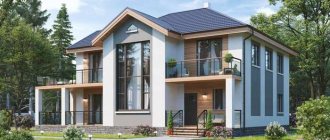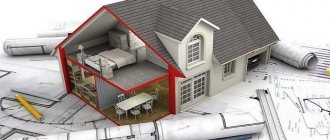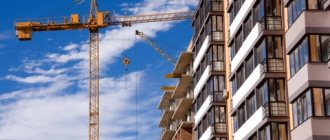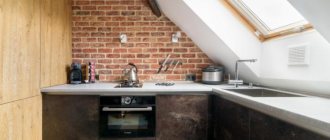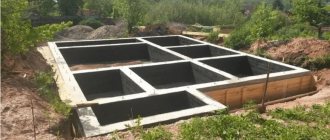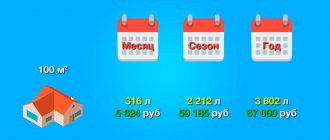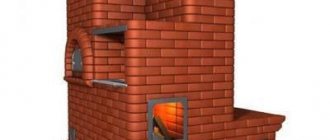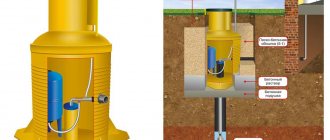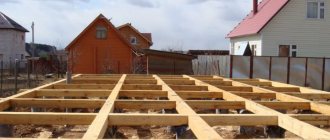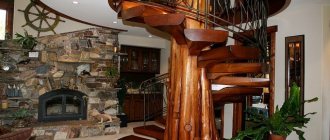Is land planning compulsory in the private sector?
In essence, the layout of a land plot (LPL) is a systematic (ordered) arrangement of the main zones and buildings on a limited territory of a land plot (LPP). The obligation to carry it out is not provided for by law, but the need is caused by objective reasons:
- There are fire and health safety standards adopted at the federal and local levels that are mandatory, as well as local requirements for private sector development plans and land use.
- The lack of ROM leads to haphazard development and tree planting, resulting in hard-to-reach areas that remain unused.
- Without ROM, as a rule, the costs of improvement caused by forced redevelopments increase.
Thus, the ROM is optional, but its absence can cause problems with regulatory authorities, unnecessary financial losses and irrational use of the ROM.
↑ Successful design = detailed plan
You shouldn’t immediately rush to buy seedlings or seedlings, equipment and finishing materials. The first step is to arrange all the elements on paper. And not just a house or a bathhouse, but every bush, every perennial flower. The more detailed, in detail, the plan for the placement of individual parts and the sequence of their implementation on your territory is, the less effort, money and time will be spent on landscaping the local area. After all, it will be a shame to spend a lot of effort and money on creating a flower garden in the place where in a year there will be a trench to supply water to an artificial pond.
Therefore, the following elements are placed on the detailed plan:
- Structures around the house, which include a veranda, summer kitchen, shed, toilet, outdoor shower, children's playground.
- Structures that are connected to water. It should be taken into account that water supply and drainage communications are carried out first.
- The location of paths is marked throughout the site.
- Stone buildings: rock garden or rock garden, cascade slides.
- Areas are allocated for planting shrubs and trees (fruit and ornamental).
- Places for flower beds are marked.
- Fences and gates. If necessary, zoning of the site is carried out using living arches and living fences.
- Small architectural and decorative elements are placed.
- Illumination of paths, territory, house facade, lighting system.
Today there are plenty of ways to bring a landscape project to life. There are landscape styles, each of them has its own motives and main concepts. But, when choosing this or that style, feel free to add your ideas and fantasies!
Types and forms: description, photo
Taking into account the purpose and characteristics of the memory, several types of memory are distinguished. The terrain necessitates the following projects:
- Horizontal layout. It is carried out without significant excavation work and practically in the same plane. Typical for fairly flat areas.
- Vertical layout. It is necessary for complex terrain and is carried out by transforming it using artificial methods (cutting, backfilling, etc.). Its purpose is to ensure the construction of a house, the formation of zones, proper water flow, ease of movement and strengthening of the landscape perspective. In addition, it is necessary when designing underground structures and communications (foundations, basements, wells, drainage and sewer systems, utilities). When carrying out it, the composition of the soil, the location of groundwater, and the level of freezing are taken into account.
The center of any site is a residential building. Based on its location, the following types of ROM are distinguished:
- Central . The plan calls for this order: backyard, house, front yard.
- Deep . The house is erected at the end of the building, and the entire territory is located in front of it.
- Front . It is more typical for urban conditions. In this case, the entrance to the residential building faces directly onto the street, and the entire plot is located behind the house.
The following layout options differ in the shape of individual zones and their orientation:
- Circular . The boundaries of the zones are round in shape, and the circles can intersect each other. This type of ROM adds originality to the landscape.
- Rectangular . This option is considered classic. All zones and buildings have a regular rectangular shape, as well as a regular direction.
- Diagonal . All the most important objects are located at an angle of 45 degrees to the house and the central entrance to the site. This ROM allows you to visually increase the area of the territory. Used for land plots with an area of 4-10 acres.
According to the style of planning there can be the following types:
- Regular style . The correct geometric shape and clear boundaries of the zones are provided.
- Landscape or picturesque style . It is characterized by complex combinations of forms, diversity of vegetation, and maximum use of the natural landscape.
- Mixed style . The site contains elements of both of these styles.
The choice of type of ROM depends on personal preferences, area of the site, topography and local traditions.
↑ Yard decoration
Many ideas have been developed for the design of the territory of a private house. Finding a suitable option is not a problem even with a modest budget. Many designs can be made with your own hands!
When beautifying the main part of the yard, use grass. Grass is planted in different ways. For example, grass seed mixtures are used to create lawns. Or a ready-made rolled grass lawn is laid on the free space.
Creating your own lawn will require time, effort and special care. Using the purchased option, it is enough to prepare the place: clear it, mark it, apply fertilizer, compact the soil and lay lawn sod. After laying the rolled lawn, it is watered every day for the first two weeks.
↑ Composition of figurines
Decorative elements are used to decorate country and garden areas. For example: wooden or forged benches, original flower beds made from scrap materials, beautiful figurines. Unusual vases and flowerpots are constructed from boards, stone, concrete and placed on the ground, or small decorative flowerpots are hung.
Recommendations for arranging your site are simple. By following them, you can create comfort and beauty in your yard. By properly planning the garden, vegetable garden and recreation area, a luxurious local area is created! And without the help of landscape designers, whose services will be expensive. Using available tools and materials, a stylish and exclusive design is created, both for a summer house and a country estate.
We recommend studying: quickly and easily making a relaxation area in your dacha with your own hands
What factors should be considered?
When carrying out ROM, the following main factors must be taken into account:
- Relief. First of all, the overall slope is assessed. The presence of hills, ravines, and lowlands plays an important role.
- Shape of the site. The traditional shape of the charger is rectangular. There are other options: triangular, trapezoidal, L-shaped.
- Soil type and structure. The best option is light, fertile soil, but sandstones, heavy clay soil, loam, and rocky outcrops may be encountered.
- The presence of natural reservoirs and the location of groundwater. This factor determines the requirements for the drainage system and construction restrictions.
- Orientation to cardinal directions and natural light.
When drafting a ROM, it is important to consider the location:
- natural objects;
- neighboring areas;
- roads;
- trunk communications;
- power lines and other objects.
The wind rose must be taken into account.
Layout of a summer cottage with a slope
When receiving a place for a summer cottage building on a slope, the owner is dissatisfied with the purchase. Indeed, the development of such a territory will require a lot of time and money. But the result will be worth it. Because in this case, the result is a unique territory that has no analogues.
An example of a dacha plot with a slope
The tips below will help you organize your area:
- The best design solution in this case would be the alpine style. The main emphasis is on all kinds of natural stones and boulders. Bright large flowers are used in the design.
Alpine style is ideal for a dacha plot with a slope
- When forming vegetation, tall plants are planted in the lower parts of the territory, and low-growing specimens are placed on the hills.
Low-growing plants are planted on high parts of the site
- No empty areas without vegetation are left on the territory. This is done not only for aesthetic reasons. Green vegetation will protect the soil from washing away.
Vegetation will protect the area from washing out
- For traffic safety, it is better to provide paths on flat terrain and stairs for moving at heights. It is convenient when the steps are all the same size. If there are several of them, it is better to provide railings.
For ease of movement, the steps should be the same size
- When planning an uneven surface, it is necessary to design a drainage system and strengthen the slopes.
Strengthening a site on a slope.
Planning a site with your own hands is not possible for a specialist. The following tips will help you organize your work correctly. The layout of the dacha plot will help to place all the necessary buildings, perform zoning, and determine the most suitable place to build a house. The building erected on the site will delight more than one generation with its coziness and comfort.
Standards for the location of buildings among themselves and in relation to neighbors' houses
When carrying out ROM and drawing up a layout plan for residential real estate and other buildings, it is necessary to take into account sanitary and fire safety standards, including the distances to the neighbors’ site, established by SNiP 30-02-97. The minimum permissible distances are:
- from a residential building to the road - at least 5 m, and from the driveway - 3 m;
- between the outermost buildings of neighboring areas - 6-15 m, taking into account the flammability of the building materials used;
- from a residential building to the border of the neighboring plot - 3 m, and for other buildings - 1 m;
- from plantings to the border of the neighboring land plot: for tall trees – 4 m, medium-height shrubs – 2 m, low shrubs – 1 m;
- from a residential building to a toilet, compost pit, buildings for keeping poultry and animals - 12 m;
- from a residential building to a bathhouse - 8 m;
- from the house to the reservoir - 30 m, river or large stream - 10 m;
- from the drinking well (well) to the toilet - 8 m.
These standards are mandatory.
Tips and tricks
So, as already mentioned, the main elements in the following categories should first be placed on the site:
- the basis is the house;
- additional buildings and outbuildings: summer kitchen, garage, well, barn, cellar and others;
- recreational buildings: terrace, patio, gazebo, playground, swimming pool and outdoor shower;
- garden and vegetable garden: flower beds, front gardens, beds for vegetables and root crops, greenhouses.
It is important to pay attention not only to their placement and shape, but also to decide on the materials that will be used during construction. Only in this case the site will achieve a harmonious garden style. The children's playground is no less important: when choosing a place, you should opt for the most visible area, so that the kids are always under the visual control of their parents.
The playground must be visible to parents
We also take into account the legal requirements regarding distance standards:
- from the house to the red line of the street - 5 m;
- from the house to the neighbor’s fence – 3 m;
- between houses made of stone - 6 m, wood - 15 m, mixed - 10 m;
- from the fence for a garden house - 3 m, buildings for animals - 4 m, outbuildings - 1 m, trees - 4 m;
- from the windows of the house to the neighbor’s utility parts – 6 m.
Standards for the location of buildings on the site
At the end of the article, a variety of examples of ready-made projects for planning summer cottages are given. Check them out and draw your own conclusions.
The best place for a garage is in the front yard. It is enough to select a small driveway for it, which will be made of strong and durable material.
What equipment will be needed?
Site planning can be done mechanically or manually.
- In the first case, heavy equipment is rented: a bulldozer or grader, a tractor with a leveling bucket, a tractor with a cultivator.
- When carrying out mechanized independent activities, a walk-behind tractor with a cultivator and a cutter for cutting soil is used.
The cheapest method is manual planning. To carry it out, you will need the following tools: a shovel (scoop and bayonet), a hoe of different sizes, a rake, a crowbar, pegs, a hammer (sledgehammer), an axe, a saw (hacksaw) for removing vegetation. To transport soil you need a wheelbarrow or cart.
Measurements and markings are made using:
- level;
- building level;
- roulettes.
Basic principles when planning a site
When drawing up a plan for a suburban area, it is necessary to take into account many different factors. For example, the shape of the plot, the buildings that are located near it, as well as the characteristics of the area can have a significant impact. In particular, the location of your land is very important.
Not all plots have a traditional rectangular shape. There are, for example, triangular ones. But the right layout can turn this disadvantage into an advantage.
You should definitely take into account whether the land is located on a hill or in a lowland, and whether there is any body of water nearby. It would be good to know what was in this place before, perhaps, there was once a forest here or it was just a piece of the steppe plain. If we take these important circumstances into account, then even on a small plot of land all the planned objects can be placed.
The following factors deserve special attention:
- Terrain. The location of utilities, the location of the main house and the necessary outbuildings may depend on how flat the plot of land is and what the surrounding landscape is like.
- Soil type. Soils in Russia can be different. There are light and fertile ones on which you can grow different plants. There may be sandy or heavy clayey soils, as well as loam. If the soil is “poor”, it will require careful care, and in some cases it will be necessary to bring special fertile soil to the site.
- Shape of the site. Not all plots are rectangular, although this shape is considered traditional. The plots can even be triangular or L-shaped.
- Reservoirs. It is important to take into account not only the proximity of ground water bodies, but also the presence of groundwater and its level. If there is groundwater and is close to the surface of the earth, you will have to install a drainage system.
- Position of the site on the sides of the horizon.
Feature #1 – terrain of the area
The location for the garden should be chosen taking into account the topography of the earth's surface. It determines in which direction the water will flow after rain or melting snow. The possible impact of spring floods on plantings is also taken into account.
The complex terrain of the site sometimes cannot be corrected, but the negative consequences arising from differences in surface levels can and should be prevented
Using the information obtained about your land plot, you can prevent some negative consequences in a timely manner. For example, to level the surface, you can remove soil somewhere and, on the contrary, add soil somewhere else. You can take care of gutters or blind areas near buildings in advance.
Slopes can be strengthened by constructing terraces, stairs, special slopes or retaining walls. Sometimes, in order to grow plants on an area with an uneven surface, it is necessary to use a vertical layout.
You can learn more about how to strengthen the slopes and slopes on the site from the material:
Feature #2 – location taking into account cardinal directions
It is very important to take into account how the site is located relative to the cardinal directions. After all, the correct placement of buildings depends on this, allowing you to use the lighting features of the allotment during daylight hours. For example, if large trees and buildings are located on the north side of the site, then the shadow cast from them will not have a negative impact on other green spaces.
Most of the house's windows should face south or southeast, allowing maximum use of natural daylight in all rooms
The house should be oriented with its façade facing south. Then his rooms will be light from dawn to dusk.
Feature #3 – taking into account reasonable traditions
Do not neglect reasonable traditions: leave a small plot of land between the facade of your house and the street for a front garden. This piece of land, filled with flowers and green plants, will serve not only a decorative function. It will protect the house from dust and street noise.
The front garden is a place where you can implement the most daring design solutions, read about it:
Having a front garden is not only beautiful, but also reasonable, since green spaces are a natural barrier to noise and dust that penetrate from outside
Scheme of a dacha land plot and placement of a residential property there
The following zones should be provided on the dacha plot:
- Residential. It includes the main residential building, as well as, if necessary, outbuildings for guests and other residential buildings. This zone has placement priority.
- Household and household. It houses all life support buildings:
- sources of drinking water;
kitchen;
- cellar;
- bath (shower);
- toilet;
- garage.
In addition, territory is required for technical and utility structures:
- sheds;
- animal enclosures;
- compost pits;
- workshops, etc.
- gazebos;
- fruit trees and shrubs;
When designing, it is important to correctly distribute the total area:
- 10-15% of the entire territory is allocated for residential areas.
- For outbuildings – up to 15%.
- Recreation may require 10 to 20% of the entire site.
- The largest area is given over to the garden and vegetable garden - from 50 to 75%.
Dividing the territory into zones
On the territory of the country estate they carry out agricultural work, grow trees, and prepare food for long-term storage. Children spend their time playing on the playground. When guests visit, the barbecue is lit and tea is served in the gazebo. There are places where one of the family members likes to lie in the sun. Men prefer to have their own workshop.
Main functional areas of a summer cottage
Country life is multifaceted and goes in many directions. In order for it to proceed harmoniously, it is good if people with different tastes, habits, and hobbies have the opportunity to retire, do what they love and not disturb others. As a precaution, it is better to move places that are undesirable for prying eyes away from the house and territory where guests have access.
An example of the layout of functional areas of a site
All these problems are solved at the stage of zoning the territory. The planning of a summer cottage begins with dividing the area into zones. On the territory of a country plot or dacha there are four zones:
1. Residential building or country house.
1. Relaxation area.
1. Place of outbuildings.
1. Garden and vegetable garden.
Sometimes access roads and paths are allocated to the fifth zone. In reality, these areas are located throughout the area and refer to the zones where they lie. The division is purely conditional, based on the experience of dividing dacha estates.
Project of a summer cottage with zoning of the territory
Depending on the owner and his plans for using the suburban space, the percentage of the allocated area may vary. Approximately, summer residents allocate up to three-quarters of the plot for a garden. Sometimes the choice is made in the direction of recreation: lawns are laid out, playgrounds are planted, lawns are planted. Therefore, there is no need to talk about any rules for dividing into zones.
Planning the placement of buildings on a site begins with choosing a site for the construction of a residential building.
House
A residential building is the cornerstone from which it all begins. The owner of the site chooses the location. But you should listen to the recommendations of experts:
- If the plot is rectangular, the house is located on the short side. This will help visually enlarge the area.
Location of the house on a rectangular dacha plot
- Those who want to have a cozy, quiet courtyard, fenced off from the bustle of the street, locate the building a short distance from the front side of the property line. And the entrance is located from the courtyard.
Location of the entrance to the summer cottage behind the house
- As explained above, housing should be located on the north side of the site so as not to form a shadow and not interfere with the growth of green spaces.
It is recommended to place the house in the northern part of the site
Relaxation area
The most beautiful part of the dacha territory is allocated for a recreation area. Guests come to this part of the territory, residents of the house relax here, children play. In this part of the dacha they plant flower beds and make beautiful paths framed with flowers. Shrubs are planted in a visible part. And even inconspicuous flowers, which fill the evening space with a pleasant aroma, are planted here.
Recreation area on a summer cottage
Gazebos are installed as buildings for this zone. Arches entwined with grapes look beautiful. An area for sun loungers, a sandbox for children and an obligatory part of country life - a barbecue. Without this, the recreation area will be incomplete.
Brazier is a traditional part of the dacha recreation area
Place of outbuildings
The economic zone refers to buildings not intended for prying eyes. It is most often removed deep into the yard. If the size of the territory does not allow, shrubs, trees, arches entwined with grapes are used for camouflage.
Disguising outbuildings with climbing plants
You can consider the option of locating utility buildings from the north or the greatest exposure to winds. In this case, the buildings will additionally protect the territory of the household from the harmful effects of wind.
Outbuildings are located in the depths of the site
You should not allocate the lowest area of the dacha for buildings. During periods of intense rainfall, this area will be impossible to reach.
Garden
For a long time, a summer cottage was unthinkable without a vegetable garden. There is currently no such practical approach. Sometimes the site is used for aesthetic pleasure. But in any of these cases, be it lawns with flower beds or garden beds, green spaces require light and it is necessary to have a source of water nearby. If the site is located at different levels, be sure to find a place in the lower part for moisture-loving plants.
Small vegetable garden on a summer cottage
Step-by-step instructions on how to properly make a project with your own hands
ROM is produced in the following order:
- Exploratory survey. It is necessary to clarify:
- terrain;
- architectural features of the area;
- soil type and structure;
- occurrence of groundwater;
- compass rose;
- orientation to the cardinal directions;
- illumination at different times of the day.
- Selecting the ROM type taking into account the updated data.
- Zoning of the storage unit. The area that can be allocated to different zones is determined. The central role is given to the residential building.
- Calculations are carried out according to standards to determine the possibility of placing various buildings in relation to a residential building, entrance and neighboring areas.
- Development of a drawing (plan diagram) of the ROM: First, the construction site of a residential building is determined.
- Next, the main zones and locations of various outbuildings are marked. Lines mark paths for people to move around.
- The next step is planning the planting of trees and shrubs.
- After all the markings are completed, the locations for the flower beds are determined. If desired, vertical gardening is planned.
- The development of the scheme is completed by the placement of small architectural forms, lighting equipment and other decorative elements.
- After this, the terrain is applied to it, and the cardinal directions are marked.
If it is decided to build a capital structure on a site, then a territory planning project, agreed upon in the prescribed manner, is needed. It is better to entrust the development of this document to a specialist, because it relates to urban planning documentation and should include detailing and clarification of all structures, linkage with access roads, and clarification of boundaries. In addition, a land surveying project may be required if the boundaries of the site are not officially established. Documents are approved by the local branch of Rosnedvizhimost.
After all the above work has been completed, you can proceed to the practical stage - planning in accordance with the project.
Getting to know the site
Before you start planning buildings, pay attention to some features of the site. Their knowledge will help you place buildings and divide the area into zones in the most convenient way.
Terrain
If the site is located on a flat surface, without hills or depressions, then this section can be ignored. The hilly terrain on one side creates difficulties when planning construction. The good news is that a house built on a hill looks great.
A house on a hill looks advantageous
Several other arguments can be made in favor of building housing on a hill.
- The high-lying building has natural protection against flooding from both spring floods and heavy rain.
- When building a house on a mountain, the basement will always be dry.
- The construction of the foundation will be completed faster and no additional waterproofing will be required.
House on a hill is protected from flooding
When placing other zones and buildings around the site, be guided by the fact that precipitation will accumulate in the lowest part of the site and flooding will occur. If you want to use these places for plants, you need to stop at moisture lovers.
Soil quality
Knowing the basic characteristics of the soil will help determine which plants will feel most comfortable in the existing area.
It is very important to determine the quality of the soil on the site
Perhaps, in order to increase the yield of future plants, it is necessary to take special measures:
1. Carry out reclamation work.
1. In some areas, due to their unsuitability for agricultural work, do not plant plants at all.
1. A good way to improve soil quality is to start new fertile soil or add fertilizer.
You can improve soil quality with complex fertilizer
Groundwater
Knowledge of the actual groundwater level will help you choose the right place to build a household and determine the need to build a drainage system.
Groundwater occurrence on the site
Information about how deep the subsoil water is will help you select trees for your future garden and decide on the choice of shrubs.
Rose of Wind
You should not ignore the fact which winds prevail in the area. The house can partially shield the site from gusts of wind. On the other hand, when choosing an interior layout, you should not allocate the sides most exposed to wind loads as bedrooms.
Location of buildings on the site according to the wind rose
Location of the site by cardinal directions
Summer residents with extensive experience in country life believe that the optimal place to locate a house is the north side. In this case, the shadow from the building does not cover the area; there is enough space left on the territory for planting green spaces. Otherwise, everything that caring hands plant on the site will not grow and develop intensively enough due to the lack of the necessary solar flow of light.
Layout of a summer cottage according to cardinal directions
Examples of ROM for 4, 6, 8, 10, 12 and 20 acres
For various summer cottages, the following standard ROM options can be offered:
- A plot of 4 acres. Planning is carried out by improving the area around the house. The following zone sections can be distinguished:
- entrance;
gardening;
- for relax;
- flower garden
- Plot of 6 acres. This is the most common area of dacha land plots. In such an area you can place:
- residential building (up to 20 m2);
outbuildings, incl. shower room, toilet, shed (15 m2);
- platform (garage) for a car (8m2);
- recreation area with children's playground (75 m2);
- vegetable garden with greenhouse (120 m2);
- other plants: trees, shrubs, flowers (320 m2);
- paths (42 m2).
- Plot 8 acres. It is possible to build a residential building with an area of up to 80 m2 (8x10 or 9x9 m). A bathhouse measuring 5x5 m will fit well. It is necessary to provide the cottage and bathhouse with water. A well is provided for this purpose. For cars, a platform with a canopy for 2 cars is best suited. A recreation area measuring 15x11 m fits between the buildings. Here you can install a gazebo, a small pool, a children's playground and a flower garden in the form of an alpine slide. The gardening area should be allocated at least 400 m2.
- Plot of 10 acres. The area is ample to accommodate a variety of design styles.
- A residential building can be up to 100 m2.
The recreation area (up to 200 m2) includes a comfortable bathhouse with a terrace, a swimming pool, a gazebo, a barbecue, and a children's playground.
- For cars, it is better to make a platform measuring 7.5x5 m.
- You can provide a utility block with a total area of up to 40 m2.
- The garden and vegetable garden can stretch over 500-600 m2.
- Plot of 12 acres. It is able to combine many necessary and useful objects:
- residential building (up to 150 m2);
outbuildings (50 m2);
- recreation area and children's playground (at least 200 m2);
- vegetable garden with greenhouse (up to 200 m2);
- garden (500-550 m2);
- paths (up to 50 m2).
- A plot of 20 acres, long rectangular in shape. The layout design depends on the location of the main entrance, i.e. entrance to the site.
- If the entrance is on the narrow side, then a transit (buffer) zone is created in front of the house, and the utility block, recreation area and gardening area are moved behind the house.
If it is possible to make an entrance along the long side, then the house will divide the plot into 2 parts: in one you can place a recreation area and a garden, and in the other a utility block and a vegetable garden.
If you have children, you should think about a small playground with swings and a sandbox. There is no need to build massive sheds and garages. It is not rational to plant trees that are too tall and bushes that are too lush.
Such a plot has a house for seasonal living. Small architectural forms can be placed in the free area.
The appearance will be improved by lawns and ornamental plants.
In such a large area, it is important to pay attention to artificial lighting and small architectural forms. A small fountain looks great.
A residential building can have an area of up to 200 m2. Additionally, on such a large area, you can equip a sports ground (for example, a tennis court).
When planning a summer cottage, you should take into account the frequency and duration of residence, the number of permanent residents and guests.
What to consider when designing
Every future landowner, before purchasing, already has a preliminary idea of what the site plan for a country house on which he will build a cozy and beautiful home for his family might look like. But it must be drawn up in the form of special design documentation after the purchase, since it must take into account and reflect important factors on which not only the location of the house, its number of floors and size, but also the convenience of the location of auxiliary facilities will depend.
Before planning a site for a country house, you need to have information about it:
- sizes;
- form;
- relief;
- groundwater and flood water levels;
- types of soil;
- degree of natural light;
- orientation to the cardinal points.
Drainage network on site
The preference for placing specific objects on a site can be influenced by one or several factors. For example, for the construction of a garden, the degree of illumination and soil fertility are important, and the layout of a site with a house in the presence of a high groundwater level may generally cast doubt on the feasibility of constructing a zero level or will require large-scale drainage work and water reduction measures.
Site drainage network plan
A detailed layout of a suburban area not only facilitates the work of developing it, but also allows you to avoid annoying mistakes, for example, the formation of so-called “dead zones” or blind corners that cannot be used effectively in the future. Once permanent structures are erected on the site and communications are installed to them, it will not be possible to make adjustments.
Layout of a small plot
Owners of small plots feel that everything is visible and clear to them at a glance. But it is precisely small-sized and non-standard-shaped territories that require increased attention, since on large ones it is much easier to make certain adjustments.
Utility plan
It is also worth considering that the layout of the site of a country house allows for the rational use of funds when laying utility networks and communications, conducting them along the most optimal route. When designing, it is important to pay attention to each object planned for construction, for example, a play area for children, which should be secluded, but under the watchful eye of adults. And for a car, it is better to place a parking lot or garage near the entrance.
When drawing up a plan for a suburban area, it will be necessary to take into account legal issues, including various requirements, many of which are regulated by local governments, so before starting work it is necessary to acquire this data.
General zoning
If the territory is very small, then in this case only the planning of the site for building a house is carried out, since there is almost no space left for the location of other objects, except perhaps for organizing a compact recreation area, combined, for example, with a playground or a small flowerbed. In other cases, work begins with the entire territory being divided into 4 main zones, that is, zoning is carried out.
At this stage, the following zones should be identified and designated:
- residential, in which the main dominant feature, naturally, will be the house and all the extensions directly adjacent to it, for example, a summer terrace, a bathhouse or a garage;
- utility room, which includes buildings for storing working tools and fuel reserves for an autonomous heating system. This may also include a garage for a car if it is located in a separate building. For lovers of raising pets, you can place chicken coops, rabbit hutches and other similar objects;
- recreation, including a separate terrace or summer kitchen, barbecue, swimming pool, playground, flower beds, gazebos and other facilities. The main requirement for its location is not far from the house, but as far as possible from the utility unit;
- vegetable garden and orchard for growing vegetables and fruits. It requires an area with maximum lighting, but depending on the preferences of the owners, it may not be present.
Proportional ratio of zones to each other
Plan diagram of the land plot
Depending on the preferences of the owners and the size of the territory, a preliminary division is made into unequal parts. As a rule, the largest plot is allocated for a country house if the total area is small. For large areas, the priority is mainly given to the garden and vegetable garden, although there are some exceptions. For example, you can organize an extended recreation area, which will also include (in addition to traditional facilities) an artificial pond or swimming pool. It is important at this stage to think about how the layout of the site of a private house is as convenient as possible for moving around it, and the space of each zone is comfortable enough for living and recreation.
After general zoning has been carried out, at this stage the work can be considered completed; general detailing is subsequently carried out for each zone separately. But before you continue with the design, you need to familiarize yourself with the regulated rules for the location of objects on sites.
Territory for construction of individual housing construction
Drawing up a project for individual housing construction (IHC) has its own specifics. The following features can be highlighted:
- Plot for construction 15 acres .
Unlike dacha plots, houses for permanent residence are built on plots for individual housing construction. Here, first of all, the life support system is set up. Construction and planning rules are strictly limited by regulatory documents (SP 30-102-99, SNiP 30-02-97 and SNiP 21-01-97). A residential building can have an area of about 200 m2, but should not exceed 3 floors in height. A source of drinking water, a drainage and sewerage system with septic tanks must be equipped. Particular attention is paid to outbuildings, the area of which can reach 80-100 m2. A bathhouse with an area of 50-60 m2 is being built. The gardening area occupies up to 600-700 m2. Enclosures for animals are provided. A permanent garage (about 30 m2) is being built for the car. - A plot for the construction of a house of 10 acres is planned according to a similar principle. The main requirement is a permanent home with an area of up to 100 m2.
When planning a land plot for individual housing construction, it is important to remember that the main housing should be located here, where the family permanently resides. All other buildings and areas are designed to ensure comfortable living.
How to place buildings on an elongated area?
Often placing buildings on a small elongated area, preference is given to this layout: the main building is located inside the courtyard. It is reached by a long straight path through the sitting area and garden. In this case, the long, elongated shape looks uninteresting and lacks any individuality or flair.
Layout of an elongated summer cottage
In order to visually expand the space, you can try the following techniques:
- In order to make the space wider, place bright objects that distract attention on one or both sides of the path. Place them not next to the path, but at a short distance from it, thereby moving apart and expanding the area of attention. As distractions, you can use benches, arches entwined with grapes or climbing flowers. Small sculptures like hedgehogs and gnomes are a good distraction. These small things will touch you and bring warmth to the surrounding landscape.
Arches entwined with climbing plants visually expand the space
- Try adding small distracting paths leading into the area to turn a long boring path into an interesting path. It’s good if you try to divide the site into zones along the length, each of which will have its own characteristics.
Zoning a summer cottage using paths
- All kinds of bushes and shrubs break up the space well and change its proportions. Especially if they are large in size and bloom with large beautiful flowers. Roses are ideal for this purpose. Constantly throughout the summer, flowering bushes of stunning beauty decorate any space, make it worthy of admiration and distract from the small perimeter area. Flowerpots and flower beds are well suited for the same purpose.
Flowering plants in a summer cottage
- Spacious lawns are completely unsuitable for a long area. Their emptiness, even very beautiful, only emphasizes the elongated shape.
Empty spaces will only emphasize the elongation of the site
Layout plan for power receiving devices
The development of a site with a residential building involves the installation of various energy receiving devices (EPD):
- heating boilers;
- sauna stoves;
- lighting system;
- pumping stations;
- electric stoves, etc.
They can be connected to single-phase (220 V) and three-phase (380 V) networks. To connect, you need a plan for the location of power receiving devices. It should reflect the technical characteristics of the equipment and the relationship of internal electrical wiring with external infrastructure.
The plan is drawn up on a scale of 1:500. Essential elements:
- connection points;
- position of power lines with the location of supports;
- underground cable routes;
- transformer installations;
- cadastral boundary of the land plot.
To develop a document, it is better to contact a specialized company.
The layout of the land allows you to optimize its use. It is carried out according to the developed project, taking into account the main influencing factors. When planning capital construction, such a document is required. Planning can be carried out using several methods depending on the area of the site and the terrain.
Drawing up a site plan
Drawing up a plan for a dacha area begins with a drawing or project, which name you like best. To do this, take a sheet of paper, even an ordinary one, in a box. And start drawing. Drawing is done to scale. For example, 1 cm of a ruler will correspond to 10 m of construction.
Sample layout of a summer cottage
The procedure for drawing up a plan is as follows: first, draw on paper the contours of the territory with all the irregularities and bends, if any. The building and outbuildings are drawn separately to scale in the form of figures, cut out and placed on the site of possible construction.
The most successful shape for a site, which opens up a beautiful picture for viewing and visually enlarges the site, is considered to be a square. Therefore, it is advisable to give the interior space of the yard a square shape.
Like a house, they cut out figures corresponding to other yard buildings: a garage, a swimming pool, a gazebo, an outbuilding. Drawing up a plan means finding a place on the site for each of the objects. The arrangement is carried out based on the above advice regarding the soil, cardinal directions, taking into account the wind rose and groundwater level. The final plan should be oriented relative to the cardinal directions.
In order to correctly navigate the placement of buildings, pay attention to the following tips from experts on drawing up plans for summer cottages:
- The main thing is to find a place to locate the house. Most often it is located at a distance of five meters deep into the yard. When choosing locations for windows, the south and north sides are the least popular. Excess light will enter the windows through the southern windows in the summer, but the northern windows will excessively cool the house in the winter.
The arrangement of rooms in the house according to the cardinal directions
- Do not place a garage or parking space in the back of the yard. These spaces occupy large areas, and they will not be able to decorate the area.
- Place all outbuildings behind the house. You shouldn’t give them the best and most visible place.
Outbuildings are located behind the house
- The part behind the house is also chosen for the vegetable garden. Do-it-yourself site planning will be of better quality if you calculate in advance how much space is needed for the vegetable garden and garden in order to place the necessary plants and trees.
- If the area is small, it is best to use rectangular buildings of regular shape. This will allow rational use of space and placement of as many buildings as possible.
Buildings on a small area should be of a simple form
- All decorative elements, such as sculptures, fountains, ponds, are designed to decorate life outside the city. It is best to open them for viewing and place them in the first part of the yard area.
- When planting plants, you must retreat five meters from buildings. This distance will protect the structure from destruction under the influence of greenery roots and prevent the formation of dampness.
- The playground should be clearly visible both from the side of the house and from the recreation area. When choosing a place for it, preference is given to the area in front of the house.
The playground should be clearly visible from all sides of the site
- To ensure that trees do not interfere with movement along the path, step back at least one and a half meters from the path.
Standards for placing plants in a summer cottage
- A hedge will be a good decoration for the yard area. It will perform several functions at once, such as decoration, protection from prying eyes. If you use fruit-bearing bushes as a hedge, you can get a large harvest of berries throughout the year.
Option for a hedge on a summer cottage
- Provide a place to rest. It is not necessary to equip a special gazebo for relaxation for this purpose. Sometimes it is enough to organize a canopy and provide a regular platform for placing sun loungers.
Cozy relaxation area with a canopy on a summer cottage
- Paths scattered throughout the territory look convenient and stylish; they not only connect buildings, but are also necessary for passage between trees and shrubs and for maintaining the vegetable garden.
Network of paths in a summer cottage
The main problems that arise when placing buildings on a site are to visually expand the boundaries of the site and make it more comfortable, which is achieved through a square shape. Let's consider the main difficulties and issues that can be solved through the correct placement of buildings or organization of the territory.
Influence of plot shape
The ideal option is to purchase a square or rectangular plot of land, but it happens that a small part of the land falls out due to the presence of a reservoir or irregular terrain.
Often such situations turn the territory into an L-shaped area, on which it is difficult to place all the necessary zones. The protruding part is given over to the construction of utility rooms or a recreation area. In any case, the location of all parts during planning depends on the shape. One of the most difficult shapes is the triangle, in which the emphasis should be on rounded shapes. This applies to the following elements:
- flower beds;
- bodies of water;
- gazebos;
- lawns.
Round shapes neutralize the minus of the triangular section.
Even in the most difficult situations, you can find a diagram that will help you successfully arrange all the elements. The main thing is not to completely copy ready-made plans, but to try to use your imagination and make some changes, taking into account your desires and the characteristics of the site.
Where can you build a garage on a plot?
Let's not forget about frequently occurring nuances.
palychch User FORUMHOUSE
I want to build a garage in the corner of the plot, using it as part of a fence. There is a roadway on both sides. The individual housing construction plot is located in the village. I'm already confused with these distances, whether this can be done or not.
PaulWist FORUMHOUSE user
If the distance to the garage complies with fire safety and sanitary standards, and more than three meters are maintained from the side driveway to the fence, then the garage can be built 1 m from the boundary on the side of the side driveway. At the same time, snow from the roof should not fall on passers-by.
From the street side, the garage can be in line with the fence. This standard is determined by local legislation, but there is judicial practice that legalizes garages on the front side of the site.
Before building something, it is better to clarify in advance whether there are any additional restrictions, for example, due to a gas pipe running close to the site, so that later you do not fear that the building will be forced to demolish.
One more nuance. Sometimes situations arise when a homeowner wants to attach a garage to an already built cottage.
DENdi FORUMHOUSE user
If the garage is built on the same foundation as the cottage and has common walls with it, then it is part of the building. Therefore, all indentations are considered as from the house. If the garage has its own foundation and its own walls, then it is an attached outbuilding. Accordingly, the indentations are considered as from an outbuilding.
Jean56 FORUMHOUSE user
And I have this situation - the plot is located on private housing construction lands. There is a building permit. I built a “box” of the house and attached a garage to the house. Those. - different foundations, only the walls and roof are adjacent. I contacted the local administration to obtain a certificate for unfinished construction. A representative arrived and stated that the construction was carried out with violations, because from the garage to the fence the distance is less than 3 m. I say that according to the standards for an extension, a retreat of 1 m is required, but she insists that it is 3 m. It turns out that everyone interprets the concept of an extension and the standards as they want.
Work plan details
Let's say your dreams are ahead of your financial capabilities. This is a common situation, but there is no need to be discouraged. Put on the plan everything that should eventually appear on your site, regardless of whether you are ready for these expenses today or not.
The time will come when you will be able to bear the new expenses, then you will be able to realize what you have planned to the fullest. It is important to include everything in the plan, and then follow it strictly. If you constantly change decisions, over time you can become convinced that chaos has formed on the site.
The process of developing and detailing the plan will be greatly facilitated by the free online garden plot designer:
At the detailing stage, not only specific objects appear on the site plan, but their parameters, drawn to scale, also begin to be drawn
Having calculated the parameters of future buildings, you need to use a scale to plot their outlines on graph paper. The more detailed the plan, the more accurate its implementation will be, and the fewer mistakes will be made in the process of its implementation.
In addition to buildings, it is necessary to draw all the elements of other zones. For example, mark fences, paths, lay out future beds and flower beds. At the same time, try to make the paths comfortable. It is not at all necessary that they be straight. Smooth curves will give them a more natural look. At the same time, your site will get rid of banality. In addition, all proposed sites must be marked on the plan, and at the same time, the paths must receive not only a direction, but also a width.
Don’t try to make the paths on your property perfectly straight; it will be inconvenient for you to use them, and you will end up rounding corners and ruining your lawn.
Now you can allocate space for trees and shrubs. Let them look like circles of the appropriate size on the plan. To decide on the types of plantings, take a reference book and select those plants that suit the area where you live. This will help to approximately estimate the upcoming primary costs of landscaping the site.
An overview of the best varieties of ornamental shrubs for arranging a garden will also be useful:
The largest trees should be located in the part of the site away from the house. The recreation area can be surrounded by decorative deciduous shrubs that bloom beautifully. Along the paths you can plant dwarf conifers or berry bushes, for example, hawthorn. Plants with large leaves and a dense crown are planted from the direction of the expected winds.
Despite the fact that the gardening area is allocated the largest area, you should not overuse tree planting: they need space to grow and develop
For flower beds we are looking for the most sunny places. Pay attention to the entrance area, seating area and space in close proximity to the house. If this plot already had owners, then it is better to leave the beds for vegetables and berries in the places where they already were. The reason is simple: the land in this place is already well-tended and it will only be enough to fertilize it in a timely manner. If you get virgin land, make beds between the recreation area and outbuildings.
Garden gazebo with barbecue. Review of 2 examples of DIY construction: https://diz-cafe.com/postroiki/besedka-s-mangalom-svoimi-rukami.html
Like flower beds, beds also do not have to have a regular rectangular shape. As you can see, a round bed for greenery, divided into sectors, is convenient and original
Next, we need to determine places for vertical gardening. Trellis, pergolas and arches should appear on the plan. Determine a place for them in such a way that they can not only become a decoration of the territory, but also hide from view the necessary, but not always quite beautiful, buildings for economic purposes.
At the final stage of drawing up the plan, you need to take care of places for small architectural forms, lighting and portable containers in which you will place beautiful ornamental plants.
Vertical gardening objects should also be displayed on the site plan of a country house: they give the area additional charm and are necessary for growing climbing plants
Now that everything you have in mind is placed on your virtual territory, make sure that the objects do not interfere with each other. There should be no empty or “blind” nooks. Every meter of territory should bring you benefits in order to please you in the future. Don't be discouraged if it undergoes some adjustments as you put this plan into action. This is acceptable. But try to follow what is planned.
Some secrets of site planning can be learned from the video:
Plan and implementation
We invite you to see which areas grew out of well-developed plans.
On FORUMHOUSE you can find answers to all questions about garden design, get acquainted with plot projects implemented and implemented by our users, read an article that talks in detail about what outbuildings are needed on a country plot and how best to place them. Watch a video on how to create a real barnyard on just one hundred square meters.
GROUNDWATER, WIND ROSE AND NATURAL LIGHTING OF THE SITE
The chief architect of the area in which your site is located should have all the information about groundwater. But such data can be obtained independently.
A well with a depth of 1.5-2 m is drilled on the territory of the land plot. If you have a plot of up to 12 acres, then you can get by with one such well. If you have 30 acres or more, you will have to drill several holes in different places on the site. After waiting for the water to settle, you need to measure its depth and, based on it, plan further work on the site. If the mark is higher than 1 meter, this means that your area is swampy. If water accumulates in the well less than 0.2 m, then the groundwater is too deep and the soil will be dry. The optimal parameter is 0.6-0.7 m.
A wind map can be obtained from your local district or regional weather service. The layout of a summer cottage largely depends on the type of prevailing winds. So, for example, if in the area where your plot is located, predominantly northern or north-eastern winds blow, then you cannot do without a protective wall of ornamental trees, otherwise landscape and garden plantings will suffer.
The location of buildings and plantings relative to the cardinal directions and the competent selection of plants, and therefore the layout of the site, depend on the natural illumination of the territory.

